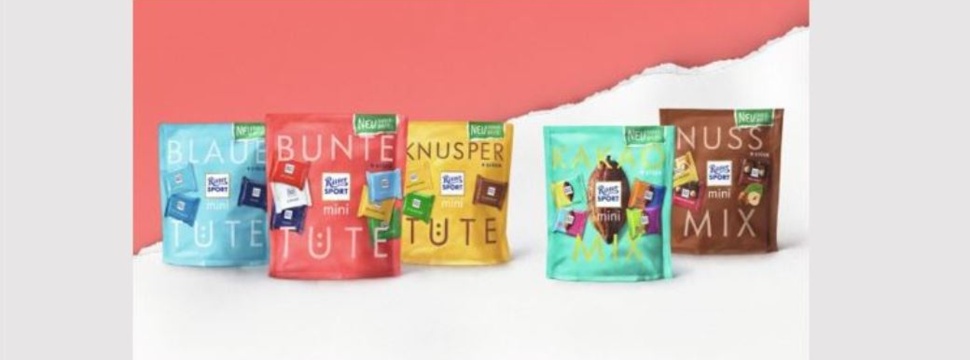Spotlight on Sustainability and Recyclability: Alfred Ritter Uses Koehler’s Flexible Packaging Paper for its “Mini Mix” Pouches
News General news
- Ritter is at the forefront of addressing changes in consumer behavior
- Koehler NexPlus® Seal flexible packaging paper used for secondary packaging
- Switch to paper pouches without need to make large investments in packaging machines
- Emotional and haptic experience with paper packaging to create new customer experience

Alfred Ritter GmbH & Co. KG aims to create packaging solutions from renewable raw materials that are in harmony with both humans and nature and recyclable. With a view to achieving this goal, the company—employing almost 1,700 staff and boasting a brand awareness of 99% in Germany—actively monitors changes in consumer behavior, changes which have grown exponentially in recent months. The concept of sustainability is becoming a key criterion in shoppers’ purchase decisions, with packaging an increasingly important factor as shoppers no longer take the individual product into sole consideration. By putting its faith in secondary packaging made from paper, Ritter is taking a leading role in addressing these changes in consumer behavior.
Ritter at the forefront of addressing changes in consumer behavior
Family company Ritter is committed to only using cocoa from certified sustainable sources across its entire product range. The use of plastic in product packaging is widespread in the FMCG sector. With a view to offering consumers a completely sustainable product, Ritter started scrutinizing packaging made from plastic back in 2018. The company considered the advantages of alternatives such as paper to be far-reaching.
Koehler’s sustainable packaging solution as replacement for plastic duplex
With Koehler NexPlus®, the Koehler Group is meeting the rapidly growing demand for sustainable packaging solutions—and this extends beyond just the food industry. Koehler NexPlus® is barrier-coated paper with various capabilities. In particular, these include barriers for odors, grease, mineral oil, water vapor, and also gases, which combine with the paper’s inherent capabilities, such as, for example, high strength properties and a natural feel, to create a strong overall concept. The paper really delivers in terms of the primary purposes of packaging: to protect the contents and their surroundings as well as provide excellent processing properties.
The requirements placed on packaging paper are high, as the paper should also possess all the same capabilities as plastic duplex materials. This includes sufficient product protection and an attractive appearance at the point of sale, and it should also serve as a communication tool for contents etc. Additionally, in the best-case scenario, the existing packaging lines should continue to be used without the need to make major adjustments when switching to paper.
Switching packaging without changing the packaging lines
Ritter sells its products in over 100 countries worldwide. With just two production sites in Germany and Austria, the company caters for the global market. Syntegon packaging machines are used at both locations. Moritz Steinle, Packaging Development Engineer at Alfred Ritter explains: “We initially carried out several test runs with Koehler’s NexPlus® Seal paper, without putting anything inside at first, and then we got closer and closer to an optimal solution by making small adjustments.” The most important aspect was the heat-sealing process, which proved essential for neat product packaging. “Sealing temperature, sealing time, and sealing pressure all need to be optimally coordinated in order to seal the finished packaging product neatly. We placed great importance on all of these criteria during the qualification process of the packaging material,” continues Steinle. Koehler NexPlus® Seal Pure 65 g is used to make the mini mix pouches. For now, both Koehler’s flexible packaging paper and the classic plastic duplex can be used, which continues to provide flexibility.
The main advantage of Koehler NexPlus® barrier paper is that it is manufactured from sustainable raw materials. They can be fully fed back into the recycling loop, possible for paper in many countries worldwide, and are also embraced by consumers. Eckhard Kallies, Head of Flexible Packaging Paper at Koehler stresses: “Barrier paper is part of our future vision. Paper has an increasing number of capabilities that in the past only plastic could offer. And the difference with paper is that it has a much more sustainable life cycle.” An analysis of the life cycle of Koehler’s flexible packaging paper shows a significant reduction of CO2 compared to conventional PE-coated paper and even plastic duplex products.
Flexible packaging paper creates emotional customer experience
The use of paper as a packaging solution in the FMCG sector offers additional advantages other than just the sustainable aspect. Tearing open a paper pouche gives the consumer an emotional and haptic experience that plastic solutions simply do not offer. The rustling of paper also provides a positive sensory experience and is associated with positive moments, such as ripping open wrapping paper. When the consumer experiences the packaging in a positive way, it both reflects onto the product and creates an emotional connection.
Paper-based secondary packaging for Ritter Sport mini mix pouches
Sustainability and recyclability were the key requirements for the paper developed by Koehler in collaboration with Ritter. Requirements that have been successfully fulfilled, given that consumers can simply dispose of the mini pouches in paper recycling trash cans so that they can be turned back into paper or cardboard. “There is a clear trend when it comes to packaging material options,” says Eckhard Kallies. “Paper scores points right across the board, and is already making an active contribution towards the objectives of a circular economy. With our flexible paper packaging solutions, we’re reducing the proportion of plastic in product packaging and making the world a bit more sustainable in the process.” The mini mix pouches have been distributed in all international markets since January, and have also been available in Germany since early March. “Open and rapid communication was ultimately crucial for the successful implementation of this project, as was close coordination with Koehler,” concludes Moritz Steinle. For Ritter it is merely the first logical step towards more sustainable packaging. Initial field tests with primary packaging have also been carried out commercially, and have been warmly embraced by consumers.










